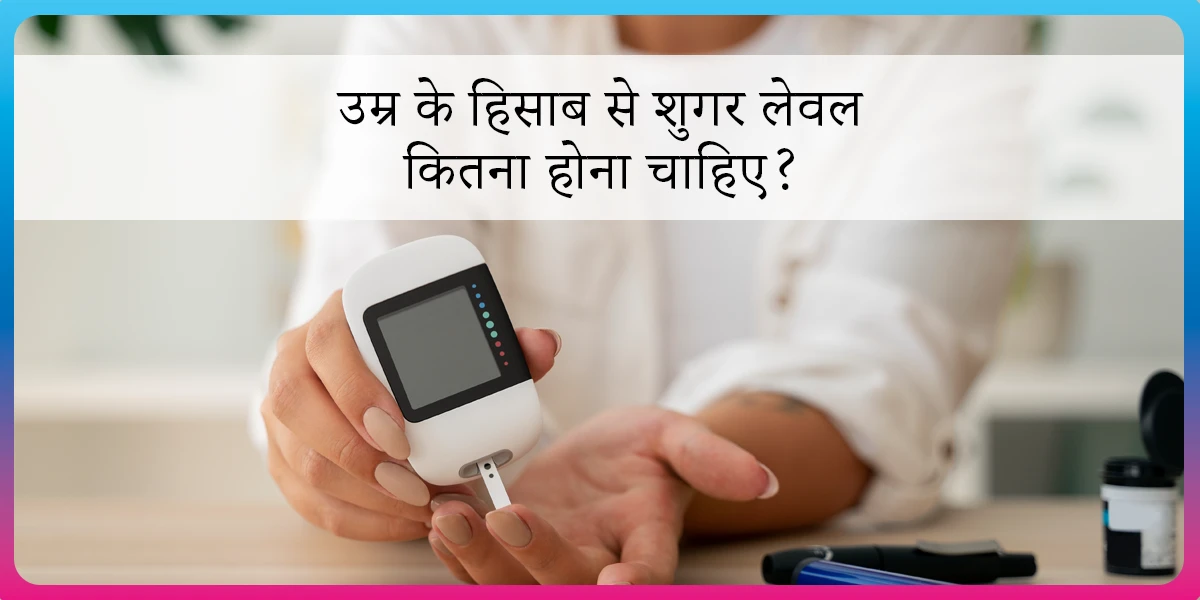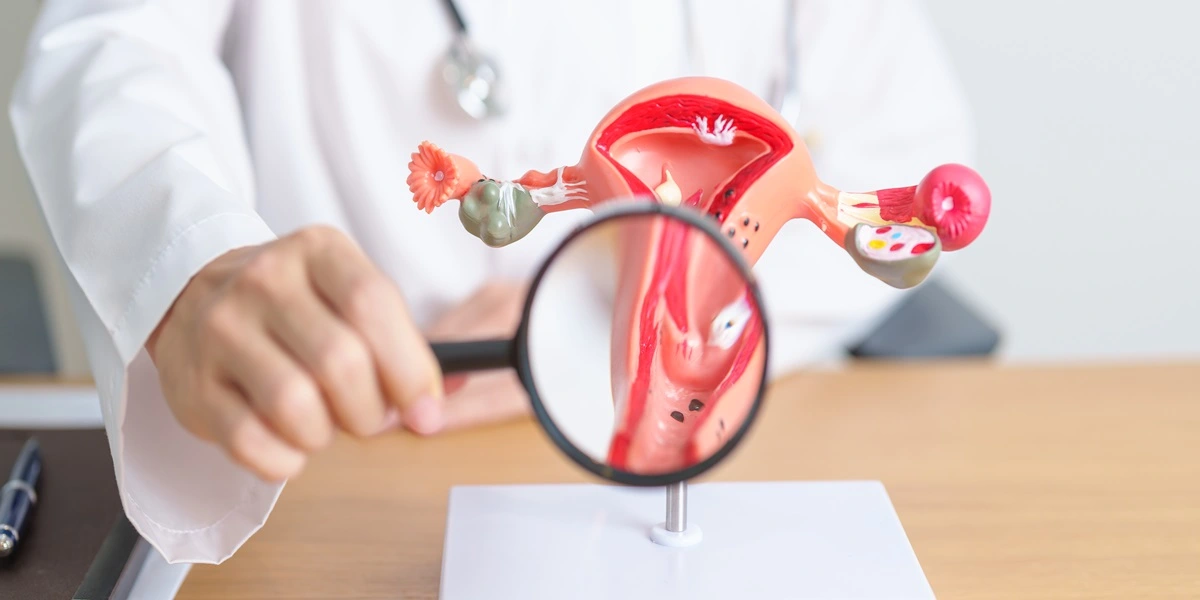10 Yoga Poses to Help You with PCOS

Many women experience irregular periods, sudden weight gain, or struggle with acne and excessive hair growth. These symptoms can feel frustrating and hard to deal with.
If this sounds familiar, you might be facing Polycystic Ovary Syndrome (PCOS), a common hormonal issue that affects many women during their childbearing years*. PCOS symptoms can make periods unpredictable, make it difficult to conceive, and bring changes to your body, but with the right support, it can be managed.
| *Childbearing years are the time when a woman can naturally get pregnant, usually between her teens and 40s. During these years, a woman’s body is most fertile. |
Many of you might not know, but September is celebrated as PCOS Awareness Month every year. It’s a time to raise awareness about the challenges women with PCOS face and the importance of managing it throughout the year. Whether it’s through medication, lifestyle changes, or practices like yoga for PCOS, there are many ways to take control of your health and feel better.
Let’s take a closer look at what PCOS is and how it affects your body.
What Exactly Is PCOS?
PCOS happens when the body’s hormones are out of balance, often causing small ovarian cysts that affect regular ovulation. But it’s not just about fertility; PCOS health risks can include conditions like high blood pressure, diabetes, and heart disease.
While this may seem challenging, there’s good news: with the right steps, PCOS symptoms can be managed effectively. In fact, it affects 8% to 13% of women.
How is PCOS Treated?
PCOS management is most often determined by the woman’s plan of becoming pregnant, and its treatment essentially includes:
- Modification in diet and physical activity
- Medications to help the ovaries release an egg normally in regular intervals
If a woman with PCOS does not plan to become pregnant, treatment for it typically includes:
- Use of birth control pills to regulate menstrual cycles, lower androgen levels and reduce acne.
- Diabetes medications may be prescribed to lower insulin resistance and androgen levels and regularise ovulation.
- Eating a healthy diet and increasing physical activity to help maintain optimal weight.
How Yoga Helps in Managing PCOS Symptoms?
Yoga is more than just physical exercise; it helps balance hormones, reduces stress, and promotes better blood circulation. Regular practice can aid in weight management, improve digestion, and even help regulate menstrual cycles.
Yoga’s focus on mindfulness and breath control also helps lower cortisol levels, which can play a significant role in managing PCOS symptoms.
Who Can Do Yoga for PCOS?
Yoga is suitable for women of all age groups dealing with PCOS. Whether you’re just starting your fitness journey or have been active for years, yoga offers gentle yet effective movements that can be tailored to suit your comfort level.
Who Should Avoid Yoga for PCOS?
While yoga is generally safe, women with severe joint pain, injuries, or certain medical conditions should consult a healthcare provider before starting a yoga routine. It’s important to listen to your body and modify poses as needed to prevent strain or injury. And this is where a trained instructor can guide you on the do’s and don’ts. Book a 1-on-1 consultation with our Fitness Expert and let them guide you.
What are the Lifestyle Changes for PCOS?
Lifestyle changes are the first line of treatment for PCOS. A few lifestyle changes that are routinely recommended to women with PCOS to help manage the condition and reduce their symptoms are:
- Reduce sugar and carbohydrate intake: Include fresh vegetables, fruits, pulses, whole grains and low-fat dairy in your diet. At the same time, reduce sugar and carbohydrate intake, which is found in processed and sweetened foods.
- Maintain optimum weight: Losing just 5% of one’s body weight is known to significantly improve PCOS and its symptoms.
- Regular exercise: Different forms of exercise and physical activities are effective in managing PCOS. However, yoga has the added benefit of mindfulness, relaxation, and breathing control, enabling better stress management. Physical exercise also helps manage insulin resistance and regulates metabolism in women with PCOS.
However, we understand that discomfort or confusion about where to start can often prevent women with PCOS from exercising. Fitterfly’s 1-on-1 online physiotherapy sessions are designed to help women with PCOS manage their physical challenges while incorporating safe and effective exercises like yoga. Our physiotherapists provide personalized guidance to help you stay consistent and achieve better health. Fill out the form below to take the first step today!
10 Yoga Poses For PCOS
Yoga has proven effects in reducing and managing PCOS symptoms along with medicine. Studies have shown that yoga for PCOS helps lower anxiety, improve hormonal balance, and regulate menstrual cycles. It also supports weight management, reduces stress, regulates blood circulation, and boosts metabolism.
1. Malasana (Garland Pose)
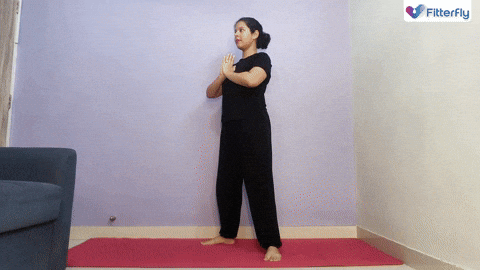
This yoga pose, or garland pose, works on your digestive system. Women prone to bloating and indigestion due to PCOS benefit from malasana. Besides this, malasana also stretches muscles at the hip, hamstrings, and lower back. This pose also helps strengthen the core and pelvic floor.
Steps To Do Malasana
- Stand with your feet slightly wider than hip-width apart.
- Turn toes to sides, slowly bend the knees, and lower the buttock
- Bring your palms together in a prayer position at your chest.
- Use your elbows to gently push your knees apart.
- Hold the position for 30 seconds to a minute while breathing deeply.
2. Setu Bandhasana (Bridge Pose)
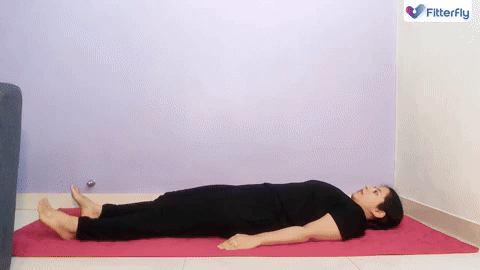

This yoga pose strengthens the back muscles and relieves any stress trapped in them. It also helps lower stress and anxiety while calming the brain, particularly for women with PCOS. Setubandhasana helps pregnant women and relieves menstrual pain.
Steps To Do Setubandhasana
- Lie down on your back with your knees bent and feet flat on the floor.
- Place your arms alongside your body, palms facing down.
- Press your feet into the floor and lift your hips towards the ceiling.
- Hold the position for 20-30 seconds and slowly lower back down.
3. Uttanpadasana (Raised Leg Pose)
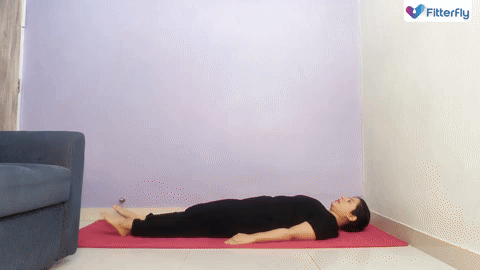

According to several studies and reports, practising uttanpadasana daily improves bowel movement, relieving acidity, indigestion, and constipation, which may be common in women with PCOS.
Steps To Do Uttanpadasana
- Lie flat on your back with your legs extended.
- Slowly lift both legs at a 45-degree angle. (do not raise your buttock off the floor or arch your back.)
- Press the back on the mat, drawing abdominal muscle tight towards the spine to avoid discomfort.
- Hold this posture and your breath for 3-5 seconds. You can increase this duration as you keep practising.
- Lower your legs slowly and repeat.
4. Naukasana (Boat Pose)


Naukasana has been proven to effectively lower blood sugar levels in people with type 2 diabetes mellitus. This may be helpful in women with PCOS who have insulin resistance or develop diabetes due to it.
Steps To Do Naukasana
- Sit on the floor with your legs extended in front.
- Lean back slightly and lift your legs off the ground.
- Extend your arms forward, keeping your spine straight.
- Hold the position for 10-15 seconds and release.
5. Pawanmuktasana (Wind Escape Pose)
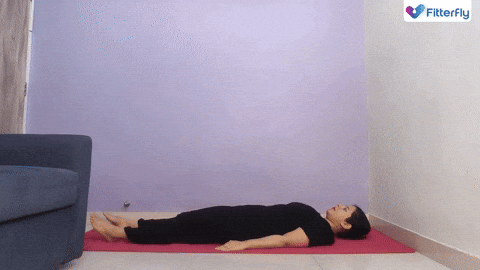

This yoga posture relieves intestinal and stomach-related issues. Pawanmuktasana also helps strengthen the back and abdominal muscles, tones the arms and legs and enhances blood circulation to the hip joints. Thus, it may be helpful for women with PCOS.
Steps To Do Pawanmuktasana
- Lie on your back and bring your knees to your chest.
- Hug your knees and press them towards your stomach.
- Hold the position for 20-30 seconds.
- Release and repeat.
6. Dhanurasana (Bow Pose)
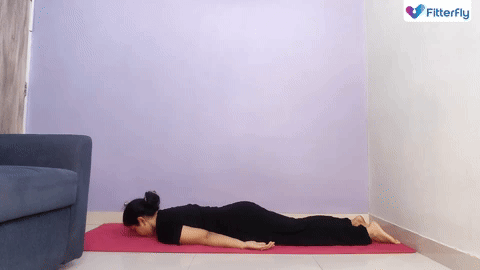

This pose is known to relieve menstrual discomfort and regulate flow. It boosts circulation to the pelvic region and releases tension from the abdominal organs. Performing this yoga asana every day can relieve anxiety and stress. For these benefits of dhanurasana, it is helpful for women with PCOS.
Steps To Do Dhanurasana
- Lie on your stomach and bend your knees.
- Hold your ankles with your hands.
- Lift your chest and thighs off the floor.
- Hold for 10-15 seconds and release.
REVERSED Diabetes in 3 months


5.7%
Happy members
EMI
Guarantee
4.8/5
Diabetes Prime Program
7. Bhujangasana (Cobra Pose)
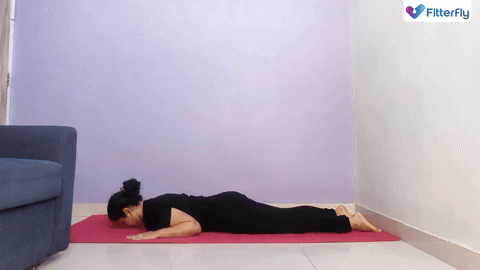

This pose strengthens the spine and opens up the chest, improving blood circulation and reducing stress levels. Bhujangasana also stimulates the abdominal organs and may help regulate hormonal imbalances in women with PCOS.
Steps To Do Bhujangasana
- Lie on your stomach with your palms below your shoulder and slightly to the side, fingers closed and facing forward.
- Keep your elbows close to the sides of the body, pointed backwards.
- Press into your hands, rolling your shoulders down, lifting your chest using the strength of your back.
- Keep your elbows slightly bent.
- Breathe naturally.
8. Baddha Konasana (Butterfly Pose)


Baddha Konasana is a gentle hip-opening pose that helps improve pelvic flexibility. It also stimulates the ovaries and kidneys, supporting reproductive health and alleviating menstrual discomfort.
Steps To Do Baddha Konasana
- Sit with your feet together, close to the groin and knees bent outward.
- Hold your feet and gently bring your knees as close to the mat as possible, keeping an upright posture.
- Hold the position for 30 seconds.
9. Supta Baddha Konasana (Reclining Butterfly Pose)
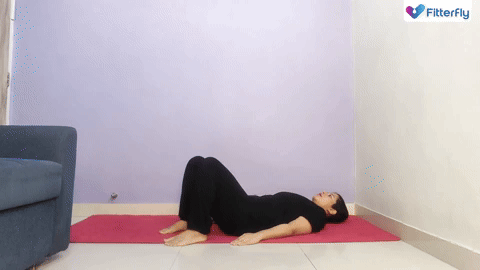

A restorative pose that deeply relaxes and enhances the flexibility of the pelvic floor muscles. Supta Baddha Konasana helps reduce stress and anxiety, two major contributors to PCOS symptoms. It also improves blood flow to the reproductive organs.
Steps To Do Supta Baddha Konasana
- Lie on your back with your knees straight.
- Then, bend the knees and slowly lower them to the side while trying to keep the soles of the feet together.
- Bring your feet together.
- Relax and hold for 30 seconds.
10. Adho Mukha Svanasana (Downward Dog Pose)
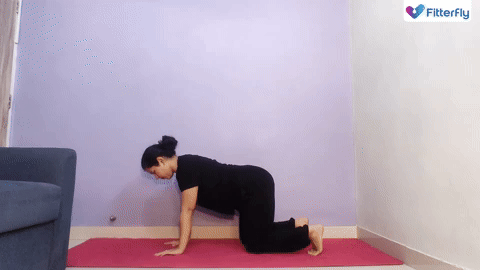

This full-body stretch improves blood circulation, reduces stress, and strengthens the arms and legs. Adho Mukha Svanasana also aids digestion and improves hormonal balance, making it beneficial for women with PCOS.
Steps To Do Adho Mukha Svanasana
- Start in a tabletop position.
- Lift your hips towards the ceiling. (The heels should come down towards the floor in the final position.)
- Keep your arms and legs straight and gaze towards the knees.
- Hold for 30 seconds and release.
Do Other Types of Exercise Help with PCOS Symptoms?
Absolutely! Managing PCOS isn’t just about doing yoga or any one type of exercise – mixing it up can do wonders. Of course, yoga is excellent, but adding strength training, pilates, and cardio workouts like jogging, HIIT, Tabata, and even dancing can make a big difference.
You should try to keep alternating between yoga and pilates with cardio and strength training. This will yield the best results and keep the fun on, too 😃
How We At Fitterfly Can Help You?
At Fitterfly, we understand how overwhelming managing PCOS can feel, especially with symptoms like weight gain, irregular cycles, and fatigue. Yoga can be a helpful way to support your health by improving hormone balance, reducing stress, and boosting circulation.
Managing PCOS, however, often requires more than exercise or diet changes. Pain, stiffness, or even fatigue can sometimes make staying active feel like an uphill battle.
If this sounds familiar, fill out this form for a 1-on-1 session with our physiotherapy coach. We’ll then call you back to better understand your challenges. Together, we’ll help you overcome the discomfort and stay active safely and comfortably.
This blog provides general information for educational and informational purposes only and shouldn't be seen as professional advice.











